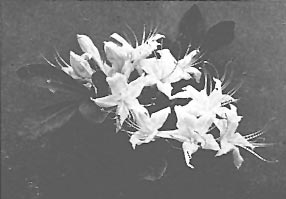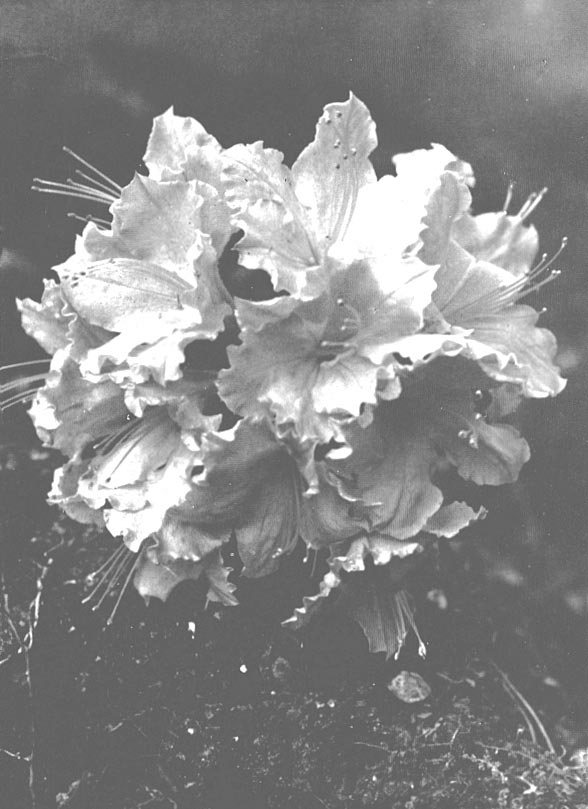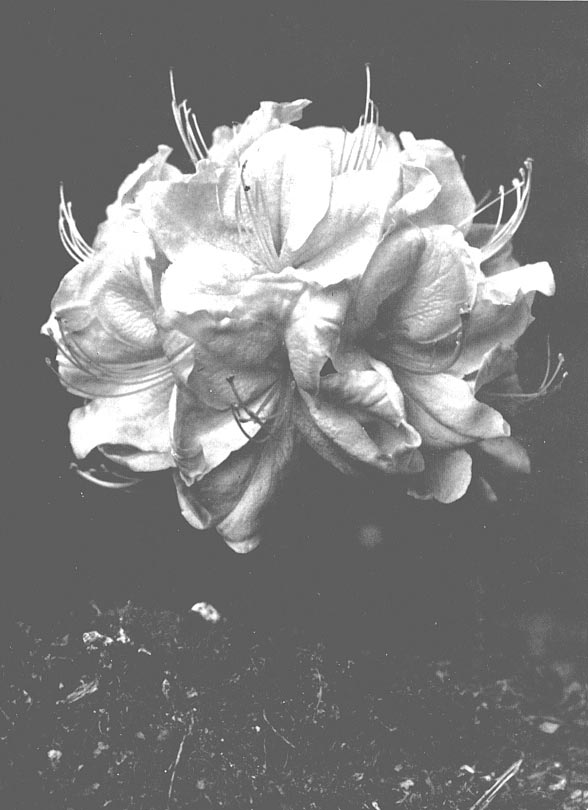QBARS - v8n4 Exbury Azaleas
Exbury Azaleas
By P. H. Brydon, Salem, Oregon
Every once in awhile there appears a new race of plants to delight the gardener. Sometimes these "breaks" occur spontaneously and are called variations or mutations. Then again they are brought about by long years of selection and breeding, resulting in a group of plants which are eminently superior to the parent stock.
Such was the case in the Knaphill azaleas, the forerunner of the present day deciduous Exbury azaleas. The Knaphill strain was created by combining selected varieties of Ghent azaleas with several North American native species plus two from the Orient, R. molle (Azalea sinensis) and R. japonicum (Azalea mollis). A total of nine species has been used in the development of the Knaphills and the Exburys, many of them being used again and again to re-introduce or emphasize a wanted character such as size of flower, color, fragrance, lateness of flowering etc. In order that we might fully appreciate the complexity of these new hybrids let us review the species whose finer qualities have been blended to produce a race of deciduous azaleas which are unexcelled for their brilliance and adaptability to low winter temperatures.

|

|

|
| Fig. 31. R. viscosum | Fig. 32. R. nudiflorum | Fig. 33. R. calendulaceum |

|

|
| Fig. 34. R. speciosum | Fig. 35. R. arborescens |
| All photos: Hilary G. Neighbors | |
About 1730, two North American species were introduced into England: namely, R. viscosum (Fig. 31), the Swamp Honeysuckle, which inhabits the swamps and moist places from Southern Maine to South Carolina, and R. nudiflorum , the Pinxterbloom of wooded areas from Massachusetts to North Carolina and westwards to Ohio and eastern Tennessee. R. viscosum is a late flowering species extending into July with small intensely fragrant flowers. Perhaps its greatest contribution to present day hybrids is the lateness of bloom, thereby missing destructive late frosts. Its fragrance and of course its hardy qualities must also be reckoned with. R. nudiflorum (Fig. 32) is without fragrance, or nearly so and has bright green foliage and tubular pink or pinkish purple flowers. It is very hardy and one of the earliest to bloom. Some of the early Ghent hybrids seem to have inherited their purplish pink color from this species.
In 1792, R. luteum or, as it is more commonly known R. flavum or Azalea pontica was introduced to England from Eastern Europe. It is an attractive plant with sweetly scented yellow flowers which appear in late May. The Dutch nurserymen have used this extensively as understock for other azalea varieties and this may explain its frequent appearance in European gardens, since on grafted deciduous azaleas, the understock often smothers the more refined varieties. R. calendulaceum (Fig. 33) and R. speciosum (Fig. 34), two closely related species, arrived in England from North America about 1800 and to them we owe the brilliant reds and scarlets of our present day hybrids. R. calendulaceum , the "Flame Azalea" is the eastern counterpart of our native R. occidentale differing from it only in the shape of the winter bud scales and the flower color. The Flame Azalea is native to the Alleghaney Mts., from Pennsylvania to Ohio and south to Georgia, and blooms in early June. The flowers are medium in size and they occur in orange, scarlet, and combinations of both shades. Its relative, R. speciosum , is more southerly in its distribution inhabiting the hilly regions of Georgia and South Carolina. It has been confused with R. calendulaceum but differs from it in its more slender corolla tube. The brilliant reds, found in Ghents, Knaphills, and Exburys are no doubt due to the influence of this species. The five species, viscosum , nudiflorum , luteum , calendulaceum , and speciosum became the foundation upon which P. Mortier of Ghent, Belgium developed his now famous Ghent Hybrids. This was in 1825 and the entire collection was acquired by Louis Verschaffelt about 1834 who then proceeded to distribute them throughout Europe. The influx of North American azaleas had attracted considerable attention among flower lovers of Europe and breeding along similar lines to those followed by Mortier was being carried on about the same time. It is believed that R. molle (Azalea sinensis) and R. arborescens (Fig. 35) were later included with the original five and all grouped together under the name of Ghent hybrids. R. molle is not to be confused with Azalea mollis, the name given to the popular azalea hybrids of nurseries. The true R. molle is native of eastern China and has large yellow flowers which have a characteristic greenish marking within the corolla. R. arborescens , the "Sweet Azalea," is the tallest of the American species attaining a height of 20 feet in its native mountains of eastern United States. The flowers are pink, or white flushed pink and are strongly fragrant.
Perhaps the real advance towards the present day hybrids was made in 1850 when Anthony Waterer Sr. of Knap Hill, England, began to combine R. molle with R. calendulaceum and Ghent hybrids. Later on selected seedlings from this group were again combined with our native R. arborescens , R. molle and R. japonicum but much hardier and more desirable as a parent plant for hybridization. It is native to Japan and blooms in May with large scentless flowers which vary in shade from orange to orange yellow and red. Our native R. occidentale needs no introduction although it could be used more often in our gardens if only for its fragrance. It was introduced to cultivation in England in 1851 and was extensively used by Anthony Waterer and Koster of Boskoop, Holland to produce a lovely race of hybrids by crossing it with R. molle and hybrids between R. molle and R. japonicum .
By back crossing on to Ghent hybrids and by introducing new blood via R. japonicum and R. occidentale , Mr. Anthony Waterer Sr. had used nine species in the development of Knaphill azaleas. Needless to say he now possessed a race of plants with untold possibilities. Genetically they had hardiness, fragrance, a wide range of color from white through the pastels to deep red, an extended flowering season, and an increase in flower size. Anthony Waterer Jr. continued to breed along the same lines as his father and about 30 years ago he was persuaded to send some of his best seedlings to Exbury, the home of the late Lionel de Rothschild, one of England's most outstanding gardeners. Lionel de Rothschild had a discerning eye for good plant material and he immediately began to work. Included in the seedlings which he received from Knaphill was an excellent yellow variety which is now called 'Geo. Reynolds', a really first class azalea with typically large square flowers of good substance. This variety along with the true R. molle (Azalea sinensis) was used intensively to improve the Knaphills. As new seedlings bloomed, Mr. de Rothschild would select two parent plants out of the pink, the reds, the yellows and so on. These he would choose for size, vigor, color, texture and then he would proceed to cross them, always keeping them within their own color category. As each succeeding generation flowered, he would ruthlessly destroy all except a few plants which measured up to his exacting standards. It is estimated that he consigned thousands of plants to the bonfire each year since he never kept a plant unless it showed a marked improvement on the preceding generation. His years of patient labor have resulted in a group of azaleas with a wide color range from pure white, soft pastel shades, to the fiery reds, oranges, and deep yellows. The flowers are immeasurably superior to the mollis types and have broad petals giving them a square look and some of them often measure as much as 4 inches across each individual flower.
Their blooming season extends from early May until early July and the flowers are carried in large trusses and in some varieties their size approaches that of rhododendrons. Most of the Exbury azaleas will form bushy shrubs averaging from 4 to 6 feet in height and about 3 to 4 feet wide. In the fall after the first touch of frost, the foliage becomes brilliant with shades of yellow and red.
CULTURE: So far as cultural requirements are concerned, they are easy to grow and will withstand zero temperatures with perfect safety. Full sun does not seem to bother them except that the flowers do not retain their fresh look for long if the day happens to be warn. To see them at their best, therefore, the plants should be given the benefit of some overhead shade during the heat of the day. Since botanically speaking they are rhododendrons, they require an acid soil and the best growth is obtained by incorporating peat moss and decaying leaves into the soil when planting. Because of their unusual vigor, it may be found advisable to prune the Exbury azaleas once in awhile to contain them, or to encourage new growth from the base. This may be carried out in spring prior to growth by removing old flowering wood, allowing young shoots to remain. It has been my observation that flowers on the young vigorous shoots produce larger and heavier trusses than those from shorter growths. They respond to dressings of acid fertilizers and this may be applied in spring as the flower buds open and again in about six weeks.
PROPAGATION: The propagation of Exbury Azaleas (and kindred types) has been by layering which is a simple operation done in late July or when the apical bud is beginning to take form. branches of the current year's growth are bent down so that the bent portion is below the soil about 4 to 6 inches. A shallow incision is made at the bend so that root formation is encouraged. A dusting with one of the rooting hormones will be of benefit. The soil where the layer is to root should be thoroughly spaded and generous amounts of peat moss and sand mixed through so that a loose friable medium is provided for the roots. After 18 months to two years have elapsed, the layer is ready to be severed from the parent plant. The best results are obtained by transplanting them in spring just prior to growth and bushier plants will result if the layers are headed back at this time. to encourage basal growth. The layers will require planting in a protected location for a year before going into their permanent location. As can be readily understood this is a slow process and for this reason stock of clonal forms of Exbury azaleas is still quite scarce. Of course they could be grafted on two year seedlings of Azalea pontica but here again there is the difficulty of the understock overcoming the scion by sending up basal shoots and it is extremely difficult to tell understock from scion so that by the time the understock has bloomed and made its presence known, it is too late to save the original` plant. Heretofore it was not considered commercially feasible to increase this type of Azalea by cuttings, but recent experiments have taught us that it can be done in certain varieties and hopefully the available stock will be greatly increased very shortly. It must be understood by the amateur gardener that in order to obtain faithful reproductions of the named varieties they must purchase plants grown from layers or cuttings. As a rule when azalea hybrids are grown from seed they do not come true to type and are often inferior to the parent in color and size. In the Exbury azaleas however, the strength of the strain through inbreeding is so strong that, if two individual plans of the same variety are cross pollinated the seedlings come remarkably true to color. I have bloomed over two thousand Exbury seedlings in Salem and I must say that I was agreeably surprised to note how constant they came from seed which had resulted from careful cross pollination at Exbury Gardens. As a matter of fact there were all sorts of beautiful color combinations in the seedlings which I have yet to see in the layers. To date the flowers on the layers have been much larger than those on the imported seedlings. However, it is too early to make comparisons for experience has taught me that it takes a year or so for the plants to settle down before the flowers attain their normal size and color. The available plants of genuine Exbury Azaleas in America are very limited and the purchaser is warned to obtain only those which are guaranteed to have their origin on the gardens of Mr. de Rothschild in Exbury, England.

|

|
|
Fig. 36. R. 'Berryrose'
Brydon photo |
Fig. 37. R. 'George Reynolds'
Brydon photo |
It is difficult to say just which are the best in the clonal varieties from Exbury-there are so many different combinations and shades of all colors, except blue. At present I am growing over 56 varieties of layers and from those which have bloomed, I would say that the following were outstanding. 'Balzac' (Award of Merit) has 12 to 14 flowers per truss and is a good red with flame markings on the upper petals, quite fragrant. 'Ballerina' is still very scarce and not in the trade as yet. It bloomed for me last year and has 14 flowers to a truss. Each flower is very large and beautifully fringed, pure white with a yellow flare on upper petal. 'Basilisk' (Award of Merit) has rich creamy yellow buds which open to deep cream with a golden flare on upper petal and 12 flowers to a truss. 'Brazil' is a showy bright tangerine red. 'Berryrose' (Fig. 36) (Award of Merit) is an excellent medium pink with yellow flare and large fragrant flowers-14 to 16 flowers per truss. 'Bright Forecast' is a salmon pink with a deep orange flare and is fragrant. 'Canasta' is a large golden yellow and fragrant. 'Cecile' has a very large square flower about 41/z inches wide. The buds are deep pink and open to a light salmon pink with a yellow flare. A vigorous grower and really outstanding. 'Favor Major' is a good orange yellow. 'Geo. Reynolds' (Fig. 37) has performed well and is a large flowered rich yellow of strong growth. 'Ginger' is a bright tangerine orange. 'Golden Horn' is a deep golden yellow. 'Gallipoli' is a striking orange scarlet. 'Gibraltar' has large fringed flowers of rich orange. 'Hotspur' (Award of Merit). There are several forms of Hotspur. This form is a striking flame with darker markings on upper petals. 'Klondyke' is a deep golden yellow. 'Nancy Buchanan' is a large white with a yellow flare. 'Orangeade' is still quite scarce. The flowers are large, fringed, and a delightful pale orange. 'Pink Delight' is a clear deep pink of wonderful substance. 'Princess Royal' is the largest flowered of them all with pale pink flowers which have a yellow shading on the interior. 'Royal Lodge' is a deep orange red and very strong growing. I have just received word from Major Barber that in the next shipment from Exbury, they will include some new varieties such as 'Sunset Boulevard', 'Frills', 'Brimstone', 'Sugared Almond', 'Sand Dune', and 'Fireball'. They all sound entrancing and I am looking forward to their flowering next spring. By now I have learned not to judge a variety too hastily since the first year after import the flowers are not very big and often lack the intensity of color, so it will be an other year before I can offer an opinion on these newer ones.
So far as the color series such as Berkshire, Derby, and so on are concerned, these are plants which have been grown from seed which was carefully hand pollinated at Exbury and as I have said previously the color is fairly constant in most cases. My reason for distributing seedlings in this manner is to make them available in quantity at a reasonable price and from what I have seen flower, they are head and shoulders above the existing mollis and other deciduous types. Furthermore they are wonderful for mass planting and really are equal in many instances to the more expensive layers.
